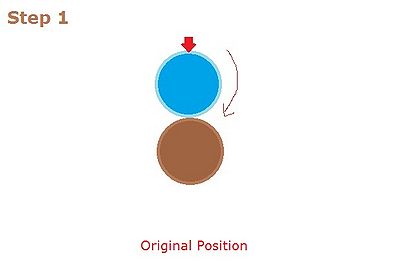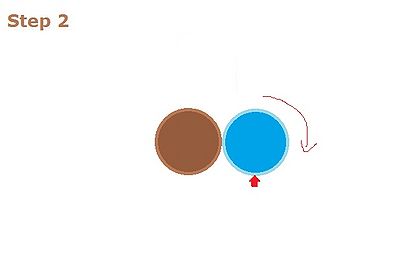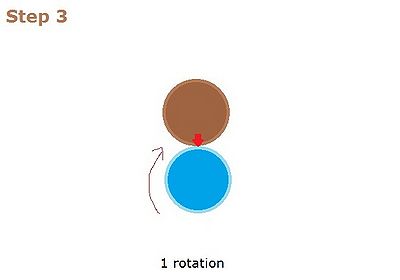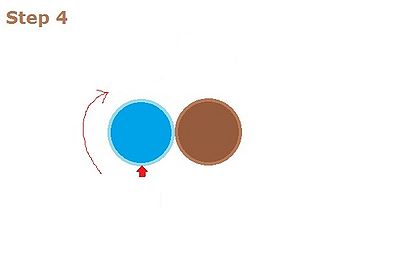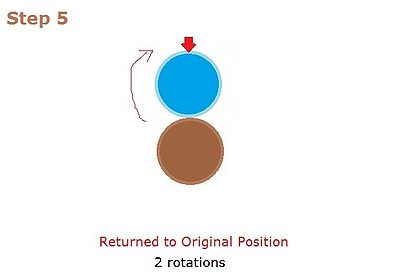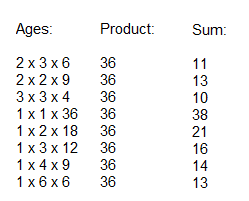Course:MATH110/Archive/2010-2011/003/Groups/Group 09/Homework 3
Q1
A bus traveled from the terminal to the airport at an average speed of 30 mi/hr and the trip took an hour and 20 min. The bus then traveled from the airport back to the terminal and again averaged 30 mi/hr. However, the return trip required 80 min. Explain.
The average speed for both the journey from the terminal to the airport and the journey from the airport back to the terminal is 30 mi/hr. So why does one take 1 hour 20 min and the other take 80 min?
The time taken for the bus to travel from the terminal to the airport is: 1 hour = 60 min 1 hour 20 min = 60 + 20 = 80 min
This is the same as the time taken for the bus to travel from the airport back to the terminal, 80 min.
Hence, it can be concluded that the time taken to and back from the airport is the same, 80 min.
Q2
A lady did not have her driver's license with her when she failed to stop at a stop sign and then went three blocks down a one-way street the wrong way. A policeman saw her, but he did not stop her. Explain.
From this question we can note 3 things:
- The lady did not have her driver's license
- She failed to stop at a stop sign
- She went 3 blocks down a one-way street the wrong way
However, the policeman noted all this but did not stop her.
All of the above is assumed to be violations if the lady were driving, and the policeman should have stopped her.
However, the question never stated that she was driving.
Hence, the logical conclusion is that the lady was probably walking, running or some other similar method of travelling.
Q3
One of three boxes contains apples, another box contains oranges, and another box contains a mixture of apples and oranges. The boxes are labeled APPLES, ORANGES and APPLES AND ORANGES, but each label is incorrect. Can you select one fruit from only one box and determine the correct labels? Explain.
For example, the boxes are labelled:
BOX 1: APPLES
BOX 2: ORANGES
BOX 3: APPLES & ORANGES
We know all the boxes have incorrect labels, therefore the possibilites for what each box contains are:
BOX 1: ORANGES or APPLES & ORANGES
BOX 2: APPLES or APPLES & ORANGES
BOX 3: APPLES or ORANGES
If we take an apple out of BOX 3 (incorrectly labelled APPLES & ORANGES), it would have to be APPLES because it cannot be ORANGES (which obviously only contains oranges). So:
BOX 3 is APPLES.
If BOX 3 is actually APPLES, then BOX 2 cannot be APPLES. Hence:
BOX 2 is APPLES & ORANGES.
Then by elimination, since BOX 2 is APPLES & ORANGES:
BOX 1 is ORANGES (the only choice left).
Q4
I am the brother of the blind fiddler, but brothers I have none. How can this be?
The person reading this question may assume that the blind fiddler is male.
However, the blind fiddler's gender is not stated in the question.
Hence, the blind fiddler is probably female, so the 'I' in the question would have a sister, not a brother.
Q5
Two quarters rest next to each other on a table. One coin is held fixed while the second coin is rolled around the edge of the first coin with no slipping. When the moving coin returns to its original position, how many times has it revolved?
From the following diagrams, it can be seen that 1 rotation will bring the second coin (blue) halfway around the fixed coin (brown), and 2 rotations will bring the second coin (blue) to it's original position:
Q6
Three kinds of apples are all mixed up in a basket. How many apples must you draw (without looking) from the basket to be sure of getting at least two of one kind?
Answer= 4 apples. if we draw four apples, we would at least have one apple that is different than the rest ( assuming that we drew different apples each time).
Q7
Suppose you have 40 blue socks and 40 brown socks in a drawer. How many socks must you take from the drawer (without looking) to be sure of getting (i) a pair of the same color, and (ii) a pair with different colors?
i) you can try by taking 3 socks. Within the 3 socks, two should be the same and one should be different.
ii) You can try by taking 3 socks. Within the three socks, there would be two that is different.
Q8
Reuben says, “Two days ago I was 20 years old. Later next year I will be 23 years old.” Explain how this is possible.
If his birthday is on the 31st of December. On the 30th of December he will be 2. On January 1st he says "Two days ago I was 20 years old. Later next year I will be 23 years old.” Later that year on december 31st he'll turn 22, so later next year he'll be 23.
Q9
A rope ladder hanging over the side of a boat has rungs one foot apart. Ten rungs are showing. If the tide rises five feet, how many rungs will be showing?
If 10 rungs are showing with a interval of 1 ft, there should be 5 rungs showing with a tide of 5 ft.
Q10
Suppose one-half of all people are chocolate eaters and one-half of all people are women.
(i) Does it follow that one-fourth of all people are women chocolate eaters? (ii) Does it follow that one-half of all men are chocolate eaters? Explain.
(i)Yes. it does. say 1/2 of people eat chocolate * 1/2 of the people are women. therefore, 1/4 of all women are chocolate eaters.
(ii) Yes it does follow because assuming half of the people are men and half are women, it does follow the same conjecture of part 1.
Q11
A woman, her older brother, her son, and her daughter are chess players. The worst player’s twin, who is one of the four players, and the best player are of opposite sex. The worst player and the best player have the same age. If this is possible, who is the worst player?
Either the son or the daughter. This is because the mother and brother cant be twins since the brother is older.
Q12
A Manhattan fellow had a girlfriend in the Bronx and a girlfriend in Brooklyn. He decided which girlfriend to visit by arriving randomly at the train station and taking the first of the Bronx or Brooklyn trains that arrived. The trains to Brooklyn and the Bronx each arrived regularly every 10 minutes. Not long after he began his scheme the man's Bronx girlfriend left him because he rarely visited. Give a (logical) explanation.
This happened because the trains to Brooklyn are minutes ahead of trains to Bronx and they arrive earlier though they take the same time; 10 minutes. since he takes the train that arrives first, he ends up rarely visiting his girl friend in Bronx, hence they broke up.
Q13
If a clock takes 5 seconds to strike 5:00 (with 5 equally spaced chimes), how long does it take to strike 10:00 (with 10 equally spaced chimes)?
10 seconds. This is because the ratio 5 seconds to 5 spaced chimes is equal to 1. 5:5=1 then ten strikes with ten spaced chimes takes ten seconds
Q14
One day in the maternity ward, the name tags for four girl babies became mixed up. (i) In how many different ways could two of the babies be tagged correctly and two of the babies be tagged incorrectly? (ii) In how many different ways could three of the babies be tagged correctly and one baby be tagged incorrectly?
(i) There are six different ways of tagging two of the babies correctly and two incorrectly.
(ii) It is impossible to get three of the babies tagged correctly and one incorrectly since there are only four in number and if three are tagged correctly, then the remaining will obviously be tagged correctly also.
Q15
Alex says to you, “I'll bet you any amount of money that if I shuffle this deck of cards, there will always be as many red cards in the first half of the deck as there are black cards in the second half of the deck.” Should you accept his bet?
I would neither accept nor refuse, since there are 52 cards in a deck and consists of 26 red cards and 26 black cards. this is because the probability of getting red or blacks cards in the first half and second half is the same, 1/2.
Q16
Suppose that each daughter in your family has the same number of brothers as she has sisters, and each son in your family has twice as many sisters as he has brothers. How many sons and daughters are in the family? Let: D= number of daughters S= number of sons
The daughter with the same number of brother and sisters also counts as another sister. Therefore, there is one less son than there are daughters: S=D-1
"Each son has twice as many sisters as he has brothers" can be represented as: D=2(S-1)
Q17
17. The zero point on a bathroom scale is set incorrectly, but otherwise the scale is accurate. It shows 60 kg when Dan stands on the scale, 50 kg when Sarah stands on the scale, but 105 kg when Dan and Sarah both stand on the scale. Does the scale read too high or too low? Explain.
I don't really know what's goin on here...but 105 kg-60 kg= 45 kg and 105 kg- 50 kg =55 kg and both those numbers give a reading that's 5 kg smaller than the number given when just one person steps on the scale.
So the scale gives readings that are higher?
Q18
18. Alice takes one-third of the pennies from a large jar. Then Bret takes one-third of the remaining pennies from the jar. Finally, Carla takes one-third of the remaining pennies from the jar, leaving 40 pennies in the jar. How many pennies were in the jar at the start?
If 1/3 is taken out each time, that means 2/3 is left in the jar each time. If you multiply the remaining 40 by 2/3's reciprocal, you should get the previous amount, since 2/3*3/2=1.
Q19
One morning each member of Angela's family drank an eight-ounce cup of coffee and milk, with the (nonzero) amounts of coffee and milk varying from cup to cup. Angela drank a quarter of the total amount of milk and a sixth of the total amount of coffee. What is the least number of people in the family?
To solve this question, I will put it into an algebraic formula.
Let:
M = total amount of milk consumed by Angela's family
C = total amount of coffee consumed by Angela's family
X = number of people in Angela's family
Angela drank 1/4 of the total amount of milk and 1/6 of the total amount of coffee, hence the first part of the formula would be:
M/4 + C/6
The rest of the formula is:
(M/4 + C/6)X = M + C
Because the amount of milk and coffee consumed by each individual person, (M/4 + C/6), has to be multiplied by the number of people, X.
And M + C is the total amount of milk and coffee consumed by the family.
Solving this equation, we get:
3M(X - 4) = 2C(6 - X)
Since M and C are both positive values, as you cannot consume negative amounts of anything, (X - 4) and (6 - X) also have to be positive.
The only possible solution for X is 5.
Therefore, the least number of people in Angela's family is 5.
Q20
20. Of two clocks next to each other, one runs 5 min per hour fast and the other runs 5 min per hour slow. At midnight the clocks show the same time. At what time are they are one hour apart?
The clocks initially are 10 minutes apart. There are 60 min/h, so for every 60 min that passes, the slower clock would be 10 min behind: 60/10.
Q21
Sven = middle of all runners so the total amount of runners should be odd -> middle of 7 is 4; but there is no middle of say, 8.
Dan is slower than Sven (in tenth place) so -> Sven > 10
Lars is in 16th place so Sven > Dan > 16
- assumed that Lars is not last as it was not stated explicitly in the question then the total runners > 16.
Therefore, the total number of runners has to be 17 because if the total number of runners exceed that, say, 19 then Sven would be number 20. However, that is not possible as the question states that he is slower than Sven at 10th place; Sven and Dan can not coexist in the same place number.
Q22
If we designate raining as R and sunny periods of time as S then we can make a simple table.
First, if it rains in the morning ---> afternoon is sunny
- rainy afternoon ---> sunny morning
Total R = 13
11 Sunny mornings
12 Sunny afternoons
Morn - R S S S S R R S S S S S R R S S R R
Noon - S S R R S S S R R S R S S S R S S S
^Sunny Mornings = 11
Sunny Noon = 12
Rainy = 13
--> Total days of vacation = 18
Q23
Products of age = 36
Oldest child = x
Second child = y
Third child = z
- then x * y * z = 36
Sum of all ages = a date
- then x + y + z = d ;; but d <= 31 (the largest amount of days in a month is 31)
A way to go about this question is to list every possibility that x, y and z will multiply to 36.
The original question states that Paul didn't get it even though it the ages add up to a date. The table above shows that all of the sums (or dates) are unique so the only possibilities are ages 2, 2, 9 and ages 1, 6, 6. However, if we assume that the oldest child and the second are not the same age (or twins) then we can say that x > y => z. So it leaves that Paula's children are ages 2, 2 and 9 respectively.
Q24
Time taken for candle A to burn out = 6 hours
Time taken for candle B to burn out = 3 hours
And to solve the question, we can say that Candle A = 2*Candle B
If we assume time starts at 0 and 'burning of the candle' is constant then:
Candle A = 6 hours then it means it will burn 1/6 per hour
Candle B = same as above; it will burn 1/3 per hour
Then Candle A = (6-x)/6
Candle B = (3-x)/6
x = time in hours
- as stated above: Candle A = 2(Candle B)
Then if we calculate the two states of Candle B before it burns out and not at its full length:
So the time it takes for one of the candle to be half of the other candle is 2 hours.
Q25
Candle A has length L and is lit at 6 h.
Candle B has length (L + 1) and is lit at 4.5 h.
At 8.5 h, Candle A = Candle B
Candle A burns out at 10 h while Candle B burns out at 10.5 h. Then the total burning time of Candle A = 10-6 = 4h; Candle B = 10.5-4.5 = 6h.
Burning time till 8.5h for Candle A = 8.5 - 6 = 2.5h
Burning time till 8.5h for Candle B = 8.5 - 4.5 = 4h
let x = candle a length ;; aka. L
let y = candle b length
--> y = x+1
let b1 = burning constant for x
let b2 = burning constant for y
-> Candle A = Candle B at 8.5 h
--> x cancels out to
---> What at B1 and B2 then?
;; at end time
;; at end time
;; the one comes from x+1
Using the above equations and substituting back into the original
--->
<-- plug in back to y=6B2
<-- plug in back to x = 4B1
Length of Candle B (longer candle) is 9 units and the length of the Candle A (shorter candle) is 8 units.
